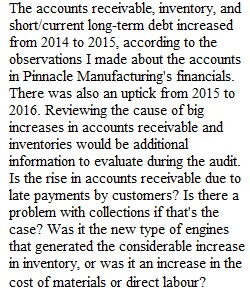


Q As part of your course work for Auditing and Assurance Services, you will have the chance to apply your learning to a case study based around an audit of Pinnacle Manufacturing. This exercise will allow you to apply auditing theory to a real-life practical audit. Starting in this module you will begin work on the first of seven parts that make-up this case study, which is based upon the procedures found in an actual certified audit. The seven parts can be found in: • Module 2: textbook chapter 8 - Part I • Module 3: textbook chapters 9, 10 and 12 - Parts II, III & IV • Module 4: textbook chapters 14, 15 and 16 - Parts V, VI and VII Note: Consult the Course Calendar for the dates when the different parts are due to be submitted for grading. Part I The Pinnacle file that you will need for Part I can be accessed using the link below. It is associated with chapter 8 of your textbook, which is assigned reading for this module. Note: You should download this file and do your work in it. When you have completed your work you should save it and upload the file to send to your mentor. Case Study File for Part I • Part I: Pinnacle Manufacturing Financial Statements Use the Add submission button below to submit your assignment.
View Related Questions